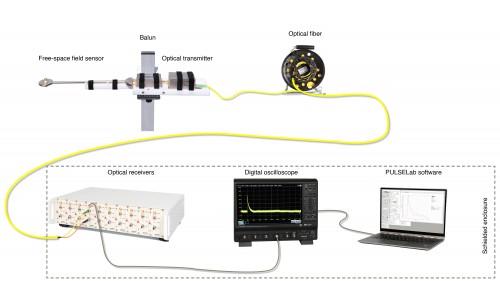Verification of B-dot and D-dot field sensors

B-dot and D-dot derivative field sensors are small broadband antennas designed to measure fast electromagnetic transients up to less than a nanosecond.
A typical measurement chain comprises the B-dot or D-dot sensor, a balun, an optical transmission system and an oscilloscope.
End user often have the requirement for an accredited calibration of the measurement chain. But there is no traceable calibration procedure (according to NIS or ISO 17025) for the B-dot or D-dot broadband derivative sensors. All manufacturers therefore use a « calibration by the ruler » method.
Those sensors are passive devices. No electronics, either active or passive, are incorporated within the sensor so that its correction factors are unaffected by such. The sensors are geometrically simple. The most accurate correction factors are determined analytically, using the Maxwell equations. It additionally is impossible to generate a calibration field with higher accuracy, why the theoretical correction factors are used.
Each sensor from Montena passes the quality inspection tests at the end of the manufacturing process, with the results recorded in the manufacturer certificates. The important dimensions of the sensor are verified and the quality of the electrical connectivity is measured with a TDR (Time Domain Reflectometry) equipment. Montena has made simulations of the sensors showing the variation of the factors in function of manufacturing mechanical tolerances.
So, each sensor shall be considered as a primary standard and unless mechanical modifications have been done to the sensor there is no need to calibrate the sensor.
It is not obvious for non-experts to determine the transfer function of a measurement chain made of a derivative sensor, a balun, some attenuators, an optical transmission link and a numerical integration. Montena proposes a verification setup based on square pulse generator and a TEM cell. The well known geometry of the TEM cell and it transfer function allows the generator of a quite precise electromagnetic field, proportional to the applied voltage. Such verification system is a quick way to verify and validate the transfer function of the measuremnt chain

EXPLORE OUR SOLUTIONS
Discover the products and technology private and governmental laboratories rely upon worldwide.
